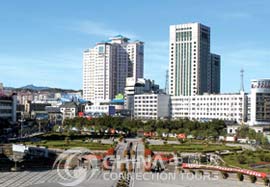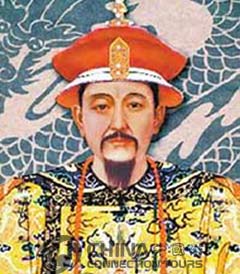
Chengde is an important commercial and heavy industrial center using nearby supplies of coal and copper to fuel an industrial base that includes machinery, electronics, meters, food processing, pharmaceuticals, tourism products, metal making, and construction materials.
 Located about 250 km northeast of Beijing, this mountain city named Bishushanzhuang (fleeing-the-heat mountain hamlet) by the Qing emperor Kang Xi offers a pleasant alternative to the summer heat of the capital. Kang Xi built a summer palace and gardens there. The palace was built between 1703 and 1792 and is a vast complex of palaces and administrative and ceremonial buildings. It served as the second political center of the Qing imperial court and the emperors of the early Qing Dynasty often spent their summers there, conducting state affairs and engaging in political activities. The palace (Chengde Ligong) gets its name from the Warm Spring (Requan) located in the northeast part of the complex. The palace with its 12 Tibetan Buddhist temples and imperial gardens subtly blend into a landscape of lakes, pastureland and forests. The palace now called “The Mountain Resort, Chengde" was added to UNESCO'S World Heritage List in 1994.
Located about 250 km northeast of Beijing, this mountain city named Bishushanzhuang (fleeing-the-heat mountain hamlet) by the Qing emperor Kang Xi offers a pleasant alternative to the summer heat of the capital. Kang Xi built a summer palace and gardens there. The palace was built between 1703 and 1792 and is a vast complex of palaces and administrative and ceremonial buildings. It served as the second political center of the Qing imperial court and the emperors of the early Qing Dynasty often spent their summers there, conducting state affairs and engaging in political activities. The palace (Chengde Ligong) gets its name from the Warm Spring (Requan) located in the northeast part of the complex. The palace with its 12 Tibetan Buddhist temples and imperial gardens subtly blend into a landscape of lakes, pastureland and forests. The palace now called “The Mountain Resort, Chengde" was added to UNESCO'S World Heritage List in 1994.
Chengde is located in the mountains between the Huabei Pingyuan (North China Plain) and Inner Mongolia Autonomous Region. It is 256 kilometers from Beijing, and is surrounded by mountains. The Re He, or Warm River, flows into the Wulie He at Chengde. The Re He is so named because the nearby hot springs raise the water temperature. Chende covers an area of 4,471 square kilometers and has four distinct seasons, with cold winters and cool summers. The average annual temperature is 4-13 C. The area averages 150 frost-free days, 2,000 hours of sunshine and 580 millimeters of rainfall annually.
The city's population is 8.5 million. Most are Han nationality, but there are Hui, Manchu, Mongolian and Korean minority nationalities as well. The major religions are Buddhism and Lamaism.
Chengde first came under Chinese control during the Liao Dynasty (907-1125). After the fall of the Mongols' Yuan dynasty (1279-1368), the succeeding Ming emperors abandoned the region.  The Manchus used the area as a base for their recon quest of China in 1644. Under the Qing (Manchu) Dynasty, which lasted until 1912, the city was known as Jehol. The Qing emperors received foreign delegations at Chengde, including the first delegation from Great Britain in 1793 during the reign of Qianlong. Chengde was captured by the Japanese and made part of Manchukuo, the Japanese puppet state in 1933. From the reign of Emperor Kang xi through that of Emperor Qianlong, nobles and important personages from every ethnic group of China were invited here to take part in contests of strength, horse racing and hunting, all of which served to draw the ethnic group leaders closer to the throne. Political factors were an important consideration as a large number of political incidents occurred here. Chengde came to be seen as unlucky after two 19th-century Chinese emperors died there, including the Jiaqing emperor who was struck by lightning near the palace in 1820. The Mountain Resort and its temples and palaces have made Chengde a famous historical and cultural city, and one of china's leading scenic spots.
The Manchus used the area as a base for their recon quest of China in 1644. Under the Qing (Manchu) Dynasty, which lasted until 1912, the city was known as Jehol. The Qing emperors received foreign delegations at Chengde, including the first delegation from Great Britain in 1793 during the reign of Qianlong. Chengde was captured by the Japanese and made part of Manchukuo, the Japanese puppet state in 1933. From the reign of Emperor Kang xi through that of Emperor Qianlong, nobles and important personages from every ethnic group of China were invited here to take part in contests of strength, horse racing and hunting, all of which served to draw the ethnic group leaders closer to the throne. Political factors were an important consideration as a large number of political incidents occurred here. Chengde came to be seen as unlucky after two 19th-century Chinese emperors died there, including the Jiaqing emperor who was struck by lightning near the palace in 1820. The Mountain Resort and its temples and palaces have made Chengde a famous historical and cultural city, and one of china's leading scenic spots.

